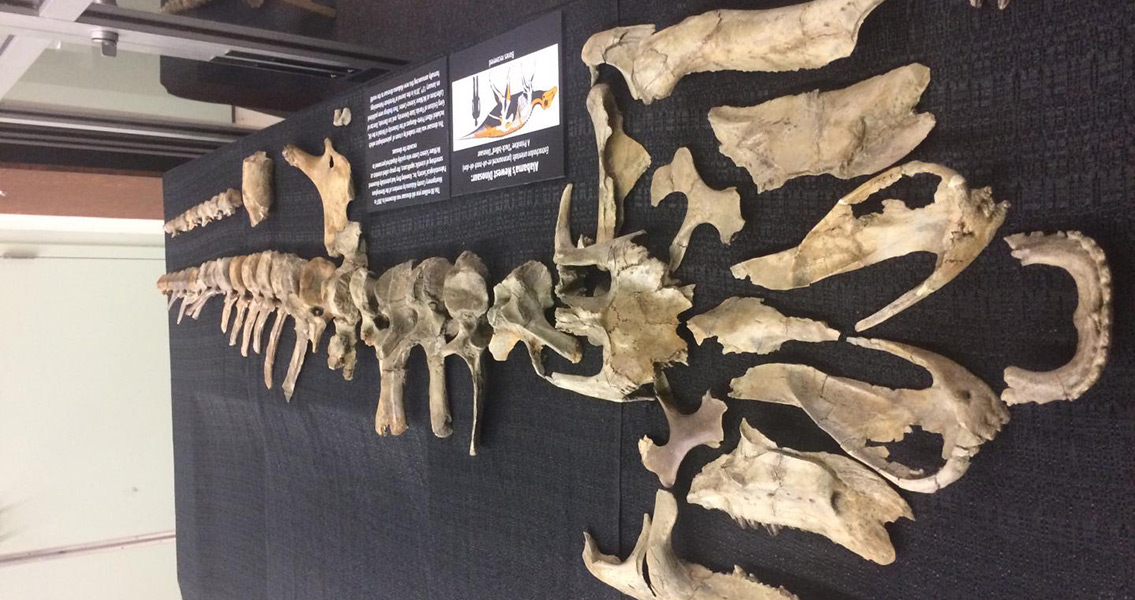<![CDATA[A new species of dinosaur has been identified and named by an international team of researchers. The newly discovered animal is likely to have been one of the earliest duck-billed dinosaurs, also known as Hadrosaurids. The skeletal remains of the 83 million year old creature were first discovered by a team of fossil enthusiasts, embedded in marine sediment alongside a creek in Montgomery County, Alabama. As soon as the group of enthusiasts realised they had discovered something unusual, they contacted the McWane Science Centre in Birmingham, Alabama, which dispatched a team to the site to extract the remains. It is exceptionally rare to find the remains of dinosaurs in the southern states of the USA. It is even rarer to find one, like this, which has a close to complete skull. The discovery also represents one of the most complete sets of dinosaur remains ever to be found in the eastern United States. Once the remains had been cleaned, a team of paleontologists began to examine the selection of bones which included a complete skull, dozens of backbones, a partial hip bone and a few bones from the limbs. The team of scientists immediately noticed the large crest on the animal's nose, something which set it apart from other Hadrosaurids. "This thing had a big ugly nose," remarked Florida State University Professor of Biological Science Gregory Erickson, one of the researchers on the team. The team named the new dinosaur Eotrachodon orientalis, which means “dawn rough tooth from the east”, the name is also a tribute to the first duck-billed dinosaur ever discovered: the Trachodon. The details of the team’s research have just been published in the Journal of Vertebrate Paleontology. Erickson and colleagues say the Eotrachodon orientalis specimen measured between 20 and 30 feet long (between 6 and 9 metres) in life. It likely walked on its hind legs, occasionally coming down on to all four to graze on plants. The team are currently unable to say for sure how old the specimen was when it died, but according to Erickson, the highly vascularised bones suggest it had been growing rapidly before its death. This could suggest it was in adolescence, and would have grown even longer had it reached adulthood. The discovery has revealed a great deal about the development of Hadrosaurids. The family of dinosaurs lived during the Cretaceous Period which lasted for roughly 79 million years, from 145.5 million to 65.5 million years ago. One of the most common families of dinosaurs from the period, Hadrosaurid remains have been found in North America, Europe and Asia. The discovery in Montgomery County shows that the duck-billed dinosaurs originated in what is now the eastern United States. “This is a really important animal in telling us how they came to be and how they spread all over the world”, said Erickson, in a press release. During the Cretaceous Period the North American continent was divided into two landmasses: Laramidia to the west and Appalachia to the east, by a 1,000 mile ocean connecting the Arctic Ocean to the Gulf of Mexico. “For roughly 100 million years, the dinosaurs were not able to cross this barrier”, said Jun Ebersole, director of collections at McWane Science Center. “The discovery of Eotrachodon suggests that duck-billed dinosaurs originated in Appalachia and dispersed to other parts of the world at some point after the seaway lowered, opening a land corridor to western North America.” For more information: www.tandfonline.com Image courtesy of Jun Ebersole, McWane Science Center]]>
New Species of Duck-Billed Dinosaur Discovered
